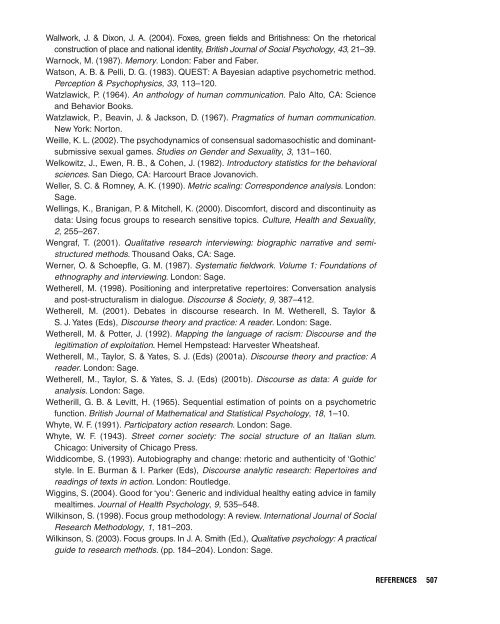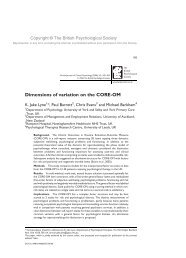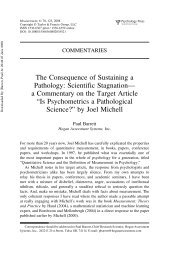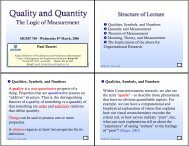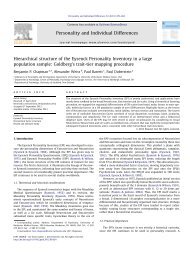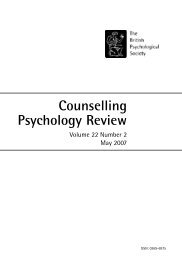Psychophysiological Methods - Paul Barrett
Psychophysiological Methods - Paul Barrett
Psychophysiological Methods - Paul Barrett
- No tags were found...
Create successful ePaper yourself
Turn your PDF publications into a flip-book with our unique Google optimized e-Paper software.
Breakwell-3389-Reference.qxd 2/7/2006 9:03 PM Page 507Wallwork, J. & Dixon, J. A. (2004). Foxes, green fields and Britishness: On the rhetoricalconstruction of place and national identity, British Journal of Social Psychology, 43, 21–39.Warnock, M. (1987). Memory. London: Faber and Faber.Watson, A. B. & Pelli, D. G. (1983). QUEST: A Bayesian adaptive psychometric method.Perception & Psychophysics, 33, 113–120.Watzlawick, P. (1964). An anthology of human communication. Palo Alto, CA: Scienceand Behavior Books.Watzlawick, P., Beavin, J. & Jackson, D. (1967). Pragmatics of human communication.New York: Norton.Weille, K. L. (2002). The psychodynamics of consensual sadomasochistic and dominantsubmissivesexual games. Studies on Gender and Sexuality, 3, 131–160.Welkowitz, J., Ewen, R. B., & Cohen, J. (1982). Introductory statistics for the behavioralsciences. San Diego, CA: Harcourt Brace Jovanovich.Weller, S. C. & Romney, A. K. (1990). Metric scaling: Correspondence analysis. London:Sage.Wellings, K., Branigan, P. & Mitchell, K. (2000). Discomfort, discord and discontinuity asdata: Using focus groups to research sensitive topics. Culture, Health and Sexuality,2, 255–267.Wengraf, T. (2001). Qualitative research interviewing: biographic narrative and semistructuredmethods. Thousand Oaks, CA: Sage.Werner, O. & Schoepfle, G. M. (1987). Systematic fieldwork. Volume 1: Foundations ofethnography and interviewing. London: Sage.Wetherell, M. (1998). Positioning and interpretative repertoires: Conversation analysisand post-structuralism in dialogue. Discourse & Society, 9, 387–412.Wetherell, M. (2001). Debates in discourse research. In M. Wetherell, S. Taylor &S. J. Yates (Eds), Discourse theory and practice: A reader. London: Sage.Wetherell, M. & Potter, J. (1992). Mapping the language of racism: Discourse and thelegitimation of exploitation. Hemel Hempstead: Harvester Wheatsheaf.Wetherell, M., Taylor, S. & Yates, S. J. (Eds) (2001a). Discourse theory and practice: Areader. London: Sage.Wetherell, M., Taylor, S. & Yates, S. J. (Eds) (2001b). Discourse as data: A guide foranalysis. London: Sage.Wetherill, G. B. & Levitt, H. (1965). Sequential estimation of points on a psychometricfunction. British Journal of Mathematical and Statistical Psychology, 18, 1–10.Whyte, W. F. (1991). Participatory action research. London: Sage.Whyte, W. F. (1943). Street corner society: The social structure of an Italian slum.Chicago: University of Chicago Press.Widdicombe, S. (1993). Autobiography and change: rhetoric and authenticity of ‘Gothic’style. In E. Burman & I. Parker (Eds), Discourse analytic research: Repertoires andreadings of texts in action. London: Routledge.Wiggins, S. (2004). Good for ‘you’: Generic and individual healthy eating advice in familymealtimes. Journal of Health Psychology, 9, 535–548.Wilkinson, S. (1998). Focus group methodology: A review. International Journal of SocialResearch Methodology, 1, 181–203.Wilkinson, S. (2003). Focus groups. In J. A. Smith (Ed.), Qualitative psychology: A practicalguide to research methods. (pp. 184–204). London: Sage.REFERENCES507


